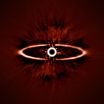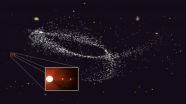(Press-News.org) SPHERE passed its acceptance tests in Europe in December 2013 and was then shipped to Paranal. The delicate reassembly was completed in May 2014 and the instrument is now mounted on VLT Unit Telescope 3. SPHERE is the latest of the second generation of instruments for the VLT (the first three were X-shooter, KMOS and MUSE).
SPHERE combines several advanced techniques to give the highest contrast ever reached for direct planetary imaging — far beyond what could be achieved with NACO, which took the first ever direct image of an exoplanet. To reach its impressive performance SPHERE required early development of novel technologies, in particular in the area of adaptive optics, special detectors and coronagraph components.
"SPHERE is a very complex instrument. Thanks to the hard work of the many people who were involved in its design, construction and installation it has already exceeded our expectations. Wonderful!" says Jean-Luc Beuzit, of the Institut de Planétologie et d'Astrophysique de Grenoble, France and Principal Investigator of SPHERE.
SPHERE's main goal is to find and characterise giant exoplanets orbiting nearby stars by direct imaging [1]. This is an extremely challenging task as such planets are both very close to their parent stars in the sky and also very much fainter. In a normal image, even in the best conditions, the light from the star totally swamps the weak glow from the planet. The whole design of SPHERE is therefore focused on reaching the highest contrast possible in a tiny patch of sky around the dazzling star.
The first of three novel techniques exploited by SPHERE is extreme adaptive optics to correct for the effects of the Earth's atmosphere so that images are sharper and the contrast of the exoplanet increased. Secondly, a coronagraph is used to block out the light from the star and increase the contrast still further. Finally, a technique called differential imaging is applied that exploits differences between planetary and stellar light in terms of its colour or polarisation — and these subtle differences can also be exploited to reveal a currently invisible exoplanet (ann13069 , eso0503) [2].
SPHERE was designed and built by the following institutes: Institut de Planétologie et d'Astrophysique de Grenoble; Max-Planck-Institut für Astronomie in Heidelberg; Laboratoire d'Astrophysique de Marseille; Laboratoire d'Etudes Spatiales et d'Instrumentation en Astrophysique de l'Observatoire de Paris; Laboratoire Lagrange in Nice; ONERA; Observatoire de Genève; Italian National Institute for Astrophysics coordinated by the Osservatorio Astronomico di Padova; Institute for Astronomy, ETH Zurich; Astronomical Institute of the University of Amsterdam; Netherlands Research School for Astronomy (NOVA-ASTRON) and ESO.
During the first light observations several test targets were observed using the many different modes of SPHERE. These include one of the best images so far of the ring of dust around the nearby star HR 4796A. It not only shows the ring with exceptional clarity but also illustrates how well SPHERE can suppress the glare of the bright star at the centre of the picture.
Following further extensive tests and science verification observations SPHERE will be made available to the astronomical community later in 2014.
"This is just the beginning. SPHERE is a uniquely powerful tool andwill doubtless reveal many exciting surprises in the years to come," concludes Jean-Luc Beuzit.
INFORMATION:
Notes
[1] Most of the exoplanets currently known were discovered using indirect techniques — such as radial velocity variations of the host star, or the dip in brightness of the star caused by a transiting exoplanet. Only a few exoplanets have so far been directly imaged (eso0515 , eso0842 ).
[2] A further, but simpler trick employed by SPHERE is to take many pictures of an object, but with a significant rotation of the image in between each. Features in the pictures that rotate are artefacts of the imaging process, and features that stay in the same place are real objects in the sky.
More information
ESO is the foremost intergovernmental astronomy organisation in Europe and the world's most productive ground-based astronomical observatory by far. It is supported by 15 countries: Austria, Belgium, Brazil, the Czech Republic, Denmark, France, Finland, Germany, Italy, the Netherlands, Portugal, Spain, Sweden, Switzerland and the United Kingdom. ESO carries out an ambitious programme focused on the design, construction and operation of powerful ground-based observing facilities enabling astronomers to make important scientific discoveries. ESO also plays a leading role in promoting and organising cooperation in astronomical research. ESO operates three unique world-class observing sites in Chile: La Silla, Paranal and Chajnantor. At Paranal, ESO operates the Very Large Telescope, the world's most advanced visible-light astronomical observatory and two survey telescopes. VISTA works in the infrared and is the world's largest survey telescope and the VLT Survey Telescope is the largest telescope designed to exclusively survey the skies in visible light. ESO is the European partner of a revolutionary astronomical telescope ALMA, the largest astronomical project in existence. ESO is currently planning the 39-metre European Extremely Large optical/near-infrared Telescope, the E-ELT, which will become "the world's biggest eye on the sky".
Links
SPHERE science page at ESO: http://www.eso.org/sci/facilities/develop/instruments/sphere.html
SPHERE information at Observatoire des Sciences de l'Univers de Grenoble: http://sphere.osug.fr/?lang=en
Photos of the VLT: http://www.eso.org/public/images/archive/category/paranal/
Contacts
Jean-Luc Beuzit
Institut de Planétologie et d'Astrophysique de Grenoble
Grenoble, France
Tel: +33 4 76 63 55 20
Cell: +33 6 87 39 62 85
Email: Jean-Luc.Beuzit@obs.ujf-grenoble.fr
Markus Feldt
Max-Planck-Institut für Astronomie
Heidelberg, Germany
Tel: +49 6221 528 262
Email: mfeldt@mpia.de
Markus Kasper
ESO
Garching bei München, Germany
Tel: +49 89 3200 6359
Email: mkasper@eso.org
Norbert Hubin
ESO
Garching bei München, Germany
Tel: +49 89 3200 6517
Email: nhubin@eso.org
Richard Hook
ESO education and Public Outreach Department
Garching bei München, Germany
Tel: +49 89 3200 6655
Cell: +49 151 1537 3591
Email: rhook@eso.org
First light for SPHERE exoplanet imager
Revolutionary new VLT instrument installed
2014-06-04
ELSE PRESS RELEASES FROM THIS DATE:
WSU researchers confirm 60-year-old prediction of atomic behavior
2014-06-04
PULLMAN, Wash.—Researchers at Washington State University have used a super-cold cloud of atoms that behaves like a single atom to see a phenomenon predicted 60 years ago and witnessed only once since.
The phenomenon takes place in the seemingly otherworldly realm of quantum physics and opens a new experimental path to potentially powerful quantum computing.
Working out of a lab in WSU's Webster Hall, physicist Peter Engels and his colleagues cooled about one million atoms of rubidium to 100 billionths of a degree above absolute zero. There was no colder place in the ...
New proactive approach unveiled to malware in networked computers and data
2014-06-04
Cybercrime comes in all forms these days. One recent headline told of the creepware or silent computer snooping that resulted in the arrest of some 90 people in 19 countries. Miss Teen USA was among the victims. Her computer had been turned into a camera and used to spy on her in her own bedroom.
On the commercial front, Target suffered the largest retail hack in U.S. history during the Christmas shopping season of 2013, and now the Fortune 500 company's outlook is bleak with steep drops in profits.
New research to be announced at the June 2014 ACM Symposium on Information, ...
Parasites fail to halt European bumblebee invasion of the UK
2014-06-04
A species of bee from Europe that has stronger resistance to parasite infections than native bumblebees has spread across the UK, according to new research at Royal Holloway, University of London.
The study, published today (Wednesday 4th June 2014) in the Journal of Animal Ecology, shows that tree bumblebees have rapidly spread despite them carrying high levels of an infection that normally prevents queen bees from producing colonies. The species arrived in the UK from continental Europe 13 years ago and has successfully spread at an average rate of nearly 4,500 square ...
Locked, loaded & feeling low: Dangers of gun ownership in the elderly
2014-06-04
In the United States the debate around gun ownership often focuses on teenagers; however, research shows that elderly Americans are the most likely to own a gun and that presents both medical and legal problems for physicians and carers.
Writing in the Journal of the American Geriatrics Society, Dr. Ellen Pinholt explores these issues and proposes a series of 'red flag' questions which caregivers must ask.
While there is no upper age limit on owning a firearm, Americans aged over 65 have the highest prevalence of dementia, depression and suicide. Federal law prohibits ...
Short intervals between pregnancies result in decreased pregnancy length
2014-06-04
Women who have short intervals between pregnancies of less than 18 months are more likely to see a decrease in the length of subsequent pregnancies, finds a new study published today (4 June) in BJOG: An International Journal of Obstetrics and Gynaecology.
The US study, using birth records from the Ohio Department of Health, looked at 454,716 live births from women with two or more pregnancies over a six year period. The researchers looked at the influence of inadequate birth spacing on the duration of the subsequent pregnancy.
The study defined short interpregnancy ...
Genes/adversity linked to crime in incarcerated sample
2014-06-04
HUNTSVILLE, TX (6/4/14) -- Researchers at Sam Houston State University have found a genetic characteristic that interacts with childhood adversity to predict higher rates of crime in an incarcerated sample.
The study is the first in a series that will examine contributions of genetic and environmental variations to criminal behavior. Published in Psychiatric Genetics, this study examines the role of monoamine oxidase A (MAOA), which has been linked to aggression, violence, and various types of childhood adversity in prior research. The study found MAOA genotype interacted ...
Count of new CFCs in the atmosphere rises from 4 to 7
2014-06-04
Scientists at the University of East Anglia have found two new chlorofluorocarbons (CFCs) and one new hydrochlorofluorocarbon (HCFC) in the atmosphere.
The research, published today in the journal Atmosphere, comes after another four man-made gases were discovered by the same team in March.
Scientists made the discovery by comparing today's air samples with air collected between 1978 and 2012 in unpolluted Tasmania, and samples taken during aircraft flights.
Measurements show that all but one of the new gases have been released into the atmosphere in recent years. ...
Astronomers discover ancient worlds from another galaxy next door
2014-06-04
An international team of scientists, led by astronomers at Queen Mary University of London, report of two new planets orbiting Kapteyn's star, one of the oldest stars found near the Sun. One of the newly-discovered planets could be ripe for life as it orbits at the right distance to the star to allow liquid water on its surface.
Discovered at the end of the 19th century and named after the Dutch astronomer who discovered it (Jacobus Kapteyn), Kapteyn's star is the second fastest moving star in the sky and belongs to the galactic halo, an extended cloud of stars orbiting ...
Iron, steel in hatcheries may distort magnetic 'map sense' of steelhead
2014-06-04
CORVALLIS, Ore. – Exposure to iron pipes and steel rebar, such as the materials found in most hatcheries, affects the navigation ability of young steelhead trout by altering the important magnetic "map sense" they need for migration, according to new research from Oregon State University.
The exposure to iron and steel distorts the magnetic field around the fish, affecting their ability to navigate, said Nathan Putman, who led the study while working as a postdoctoral researcher in the Department of Fisheries and Wildlife, part of OSU's College of Agricultural Sciences.
Just ...
Two planets orbit nearby ancient star
2014-06-04
Washington, D.C.— An international team of astronomers, including five Carnegie scientists, reports the discovery of two new planets orbiting a very old star that is near to our own Sun. One of these planets orbits the star at the right distance to allow liquid water to exist on its surface, a key ingredient to support life. Their work is published by Monthly Notices of the Royal Astronomical Society.
Kapteyn's Star, named after the Dutch astronomer, Jacobus Kapteyn, who discovered it at the end of the 19th century, is the second fastest-moving star in the sky and belongs ...
LAST 30 PRESS RELEASES:
Young adults commonly mix cannabis with nicotine and tobacco
Comprehensive review illuminates tau protein's dual nature in brain health, disease, and emerging psychiatric connections
Book prepares K-12 leaders for the next public health crisis
Storms in the Southern Ocean mitigates global warming
Seals on the move: Research reveals key data for offshore development and international ecology
Sports injuries sustained during your period might be more severe
World's first successful 2 Tbit/s free-space optical communication using small optical terminals mountable on satellites and HAPS
Can intimate relationships affect your heart? New study says ‘yes’
Scalable and healable gradient textiles for multi‑scenario radiative cooling via bicomponent blow spinning
Research shows informed traders never let a good climate crisis go to waste
Intelligent XGBoost framework enhances asphalt pavement skid resistance assessment
Dual-function biomaterials for postoperative osteosarcoma: Tumor suppression and bone regeneration
New framework reveals where transport emissions concentrate in Singapore
NTP-enhanced lattice oxygen activation in Ce-Co catalysts for low-temperature soot combustion
Synergistic interface engineering in Cu-Zn-Ce catalysts for efficient CO2 hydrogenation to methanol
COVID-19 leaves a lasting mark on the human brain
Scientists use ultrasound to soften and treat cancer tumors without damaging healthy tissue
Community swimming program for Black youth boosts skills, sense of belonging, study finds
Specific depressive symptoms in midlife linked to increased dementia risk
An ‘illuminating’ design sheds light on cholesterol
Who is more likely to get long COVID?
Study showcases resilience and rapid growth of “living rocks”
Naval Research Lab diver earns Office of Naval Research 2025 Sailor of the Year
New Mayo-led study establishes practical definition for rapidly progressive dementia
Fossil fuel industry’s “climate false solutions” reinforce its power and aggravate environmental injustice
Researchers reveal bias in a widely used measure of algorithm performance
Alcohol causes cancer. A study from IOCB Prague confirms damage to DNA and shows how cells defend against it
Hidden viruses in wastewater treatment may shape public health risks, study finds
Unlock the power of nature: how biomass can transform climate mitigation
Biochar reshapes hidden soil microbes that capture carbon dioxide in farmland
[Press-News.org] First light for SPHERE exoplanet imagerRevolutionary new VLT instrument installed





